Chapter 296-860 WAC
Last Update: 12/1/15RAILROAD CLEARANCES AND WALKWAYS IN PRIVATE RAIL YARDS AND PLANTS
WAC Sections
| HTMLPDF | 296-860-099 | Definitions. |
| HTMLPDF | 296-860-100 | Scope. |
| HTMLPDF | 296-860-200 | Maintain safe clearances and walkways. |
| HTMLPDF | 296-860-20010 | Post warning signs and train employees about clearances approved before April 3, 1961. |
| HTMLPDF | 296-860-20020 | Construct and maintain rail yard walkways for employee safety. |
| HTMLPDF | 296-860-20030 | Install radiation detectors according to manufacturer's specifications. |
| HTMLPDF | 296-860-20040 | Maintain overhead clearances. |
| HTMLPDF | 296-860-20050 | Maintain side clearances. |
| HTMLPDF | 296-860-20060 | Maintain clearances between tracks. |
| HTMLPDF | 296-860-20070 | Move excessive height or width rail car loads with care. |
| HTMLPDF | 296-860-20080 | Follow these requirements to conduct narrow gauge rail operations. |
DISPOSITION OF SECTIONS FORMERLY CODIFIED IN THIS TITLE
| 296-860-300 | Definitions. [Statutory Authority: RCW 49.17.010, [49.17].040, and [49.17].050. WSR 02-17-106, § 296-860-300, filed 8/21/02, effective 10/1/02.] Repealed by WSR 15-24-102, filed 12/1/15, effective 1/5/16. Statutory Authority: RCW 49.17.010, 49.17.040, 49.17.050, 49.17.060. |
PDF296-860-099
Definitions.
The following definitions apply to this chapter:
Car width. Twice the distance from the centerline of a railroad car to its extreme outside part.
Common carrier. All railroads, railroad companies, street railroads, street railroad companies, corporations, partnerships, persons, cities or towns that own, operate, manage, or control any public use enterprise within Washington state that transports people or property for hire.
Department. The Washington state department of labor and industries.
Emergency. Any unforeseen occurrence that endangers life, limb, or property.
Icing platforms. Structures used to ice, precool, heat, ventilate or service private railroad cars that handle commodities requiring these services.
Over-crossing. Any point or place where a highway, road, or ramp carrying vehicular traffic crosses a private rail yard or track by passing above it.
Overhead clearance. The perpendicular distance between the top of the highest rail and the lowest point of an overhead structure or obstruction.
Private rail operation. A nonrailroad company operating railroad facilities, structures, tracks and equipment in the company's yard or plant. Chapter 296-860 WAC applies to:
(a) Any equipment, facility or structure owned or operated by the company; and
(b) The construction and reconstruction of tracks or structures adjacent to any facility or structure owned or operated by the company.
Railroad. Every public use railroad, other than street railroads, operated to transport people or property for hire. This definition also includes all bridges, ferries, tunnels, equipment, switches, spurs, tracks, stations, and terminal facilities of every kind that are used, operated, controlled, or owned by or in connection with any such public use railroad.
Side clearance. The shortest distance between the centerline of a track and a structure or other track side obstructions such as downspouts, ladders, equipment, piles of material or inventory, etc.
Track clearance. The shortest distance between the centerlines of adjacent railroad tracks.
Walkways. Pathways located alongside or in the vicinity of a railroad track, or on a trestle or bridge, providing space so a private railroad employee can perform duties associated with the track, trestle, or bridge.
PDF296-860-100
Scope.
Important:
This chapter applies to all railroad clearances and walkways in rail yards and plants including logging railroad yards such as mill yards, maintenance yards and sorting yards. If you are uncertain about which WISHA requirements to follow, you must comply with those that best protect employees' safety and health. Contact your local L&I office if you need assistance in making this decision.
exemptions:
These exemptions apply to chapter 296-860 WAC, Railroad clearances and walkways in private rail yards and plants, and do not require a department variance:
1. You may move the following equipment, using less than the minimum standard clearances, if the situation is unavoidable and you have taken all reasonable steps to protect your employees:
a. Track construction or maintenance materials.
b. Special work equipment used for railroad construction, maintenance or operations.
c. Any railroad equipment during emergencies.
2. You may have overhead or side clearances less than the minimum standard clearances required in this chapter if they were legally created before April 3, 1961.
3. Tracks built before April 3, 1961:
a. May be extended according to the legal track clearance requirements in effect when they were originally constructed.
b. Are exempt from the track clearance requirements in WAC 296-860-20060, Table 5.
4. Chapter 296-54 WAC, Safety standards—Logging operations, regulates all logging railroads or any rail operations related to logging, except for yard clearances.
Note: | If a building, structure, or facility constructed before April 3, 1961, is relocated or reconstructed, the clearance requirements in this chapter apply unless the department grants a variance. |
Other rules that may apply to your workplace:
(1) The DOSH Safety & Health Core Rules book, chapter 296-800 WAC, contains the basic requirements that apply to employers in Washington. It also contains:
(a) An introduction that lists important information you should know, including a section on building, fire and electrical codes.
(b) A resource section that includes a complete list of all DOSH rules.
(2) Other DOSH rules may apply to you, depending upon the activities and operations of your workplace. Contact your local L&I office if you are uncertain about which DOSH requirements pertain to you.
(3) To access the Safety & Health Core Rules book online: http://www.lni.wa.gov/safety/rules/chapter/800/default.asp.
(4) For a CD or paper copy contact us:
Labor and Industries
P.O. Box 44620
Olympia, WA 98504-4620
Telephone: 1-800-4be-safe (1-800-423-7233)
[Statutory Authority: RCW 49.17.010, 49.17.040, 49.17.050, 49.17.060. WSR 15-24-102, § 296-860-100, filed 12/1/15, effective 1/5/16; WSR 07-03-163, § 296-860-100, filed 1/24/07, effective 4/1/07. Statutory Authority: RCW 49.17.010, [49.17].040, and [49.17].050. WSR 02-17-106, § 296-860-100, filed 8/21/02, effective 10/1/02.]
PDF296-860-200
Maintain safe clearances and walkways.
Summary
Your responsibility:
To prevent injuries and fatalities to employees by maintaining safe railroad clearances and walkways in your rail yards and plants.
You must meet the requirements… | in this section: |
Post warning signs and train employees about clearances approved before April 3, 1961 | WAC 296-860-20010 |
Construct and maintain rail yard walkways for employee safety | WAC 296-860-20020 |
Install radiation detectors according to manufacturer's specifications | WAC 296-860-20030 |
Maintain overhead clearances | WAC 296-860-20040 |
Maintain side clearances | WAC 296-860-20050 |
Maintain clearances between tracks | WAC 296-860-20060 |
Move excessive height or width rail car loads with care | WAC 296-860-20070 |
Follow these requirements to conduct narrow gauge rail operations | WAC 296-860-20080 |
PDF296-860-20010
Post warning signs and train employees about clearances approved before April 3, 1961.
(1) You must post warning signs near tracks with clearances approved before April 3, 1961, so employees are aware of the minimal clearances and their potential hazards. The signs must:
(a) Be highly visible.
(b) Be easy to read.
(c) Alert employees to the danger of railway equipment operating on your yard and plant tracks.
(2) You must include in your employee safety and health training information about:
(a) Any minimal clearances and their location.
(b) Potential hazards associated with them.
(c) The location of any clearance warning signs.
PDF296-860-20020
Construct and maintain rail yard walkways for employee safety.
Important:
You have two years from October 01, 2002, (the effective date of this rule), to comply with the construction requirements of this section, unless the department determines during an inspection that your walkways create a serious safety hazard. If you are not sure a serious safety hazard exists in your workplace, you can request a free consultation from the department by calling your local L&I office.
Construction of walkways
(1) You must build walkways in rail yard areas where employees regularly work on the ground.
(2) You must construct rail yard walkways that can be maintained in a safe condition:
(a) With reasonably smooth walking surfaces.
(b) That will not interfere with track drainage.
(3) You must use any of the following materials when constructing your walkway:
(a) Crushed material that does not exceed 1 1/2 inches in size. For this rule, "1 1/2 inches in size" means one of the following (percentages refer to weight measurement and sieve size standard in the industry):
Percentage of material passing through a sieve opening | Sieve opening size | ||||
100 | 1 1/2 inch square | ||||
90 | - | 100 | 1 inch square | ||
40 | - | 80 | 3/4 inch square | ||
15 | - | 60 | 1/2 inch square | ||
0 | - | 30 | 3/8 inch square | ||
0 | - | 10 | #4 | ||
0 | - | 5 | #8 | ||
0 | - | 0.5 | #200 | ||
(b) Smaller crushed material is preferred and should be used where drainage and durability is not an issue. Crushed material that is 3/4 inch or less in size is recommended for switching leads in yards.
(c) Asphalt, concrete, planking, grating, or other similar material.
(d) Natural materials such as gravel or dirt.
(4) You must construct walkways wide enough for employees to safely perform their duties.
(5) You must construct walkways with a grade or slope in any direction with not more than one inch of elevation for each eight inches of horizontal length, unless it is geographically impractical.
Maintenance of walkways
(6) You must keep all walkways clear of vegetation, debris, mud, or other obstructions that create a potential hazard for employees.
(7) You must remove all standing water from all walkways as soon as reasonably possible.
(8) You must reopen walkways temporarily closed for a construction project within thirty days after the project is completed.
(9) You must repair walkways that have been damaged and temporarily closed because of an emergency within thirty days after the emergency ends.
(10) You must obtain a department variance before permanently removing any bridge or trestle walkway from use after October 1, 2002 (the effective date of this rule).
Note: | The requirements for filing a variance are located in the safety and health core rules and chapter 296-900 WAC, Administrative rules. |
[Statutory Authority: RCW 49.17.010, 49.17.040, 49.17.050, 49.17.060. WSR 15-24-102, § 296-860-20020, filed 12/1/15, effective 1/5/16; WSR 07-03-163, § 296-860-20020, filed 1/24/07, effective 4/1/07. Statutory Authority: RCW 49.17.010, [49.17].040, and [49.17].050. WSR 02-17-106, § 296-860-20020, filed 8/21/02, effective 10/1/02.]
PDF296-860-20030
Install radiation detectors according to manufacturer's specifications.
Important:
This section applies only to those private yards and plants where the installation of radiation detectors beside railroad tracks is required due to the nature of the business; for example, scrap metal yards.
(1) You must install radiation detectors beside the railroad tracks in your yard and/or plant according to the manufacturer's specifications.
(2) You must post signs on each radiation detector installed less than eight feet six inches from the centerline of the track:
(a) Warning employees that the side clearances between the detector and the track centerline are less than the required standard minimum side clearances found in this chapter.
(b) Prohibiting employees from riding on the side of any rail car passing through the detector.
PDF296-860-20040
Maintain overhead clearances.
exemption:
Engine houses and car shops are exempt from the overhead clearance requirements of this section.
You must make sure overhead railroad clearances are at least twenty-two feet six inches unless a clearance requirement found in Table 1 applies.
Note: | 1. Clearance requirements are based on the assumption that generally used rail equipment in private yards and plants is no more than ten feet ten inches wide by fifteen feet six inches high. |
2. WAC 296-860-20070 regulates the use of any rail equipment that exceeds the above dimensions. | |
3. Minimum vertical clearances for all overhead wires are specified in Parts 1, 2, and 3 of the National Electrical Safety Code (NESC) as referenced in WAC 296-45-045, electrical workers safety rules, NESC applicable. See NESC 231 and 232. |
Table 1 - Minimum Overhead Clearances for Buildings, Structures, Tunnels, and Bridges
If your overhead clearance involves: | Then the minimum overhead clearance requirements are: | |
An entirely enclosed building | 18 feet when tracks end inside an entirely enclosed building. Also: | |
• | The department must approve any reduction from 22 feet 6 inches before the reduction takes place. | |
• | If an overhead clearance is less than 22 feet 6 inches, all cars, locomotives or other equipment must come to a full stop before entering the building. | |
• | See Illustration 1. | |
All other structures | Defined by the half-circumference of a circle whose: | |
• | Radius is 8 feet 6 inches; and | |
• | Center is located on a line perpendicular to the track's centerline and 14 feet above the top of the highest rail. | |
• | See Illustration 1. | |
Tunnels, over-crossings, and bridges | Defined by the half-circumference of a circle whose: | |
• | Radius is 8 feet; and | |
• | Center is located on a line perpendicular to the track's centerline and 14 feet 6 inches above the top of the highest rail. | |
• | See Illustration 1. | |
Illustration 1 - Minimum Overhead Clearances for Buildings, Structures, Tunnels, and Bridges
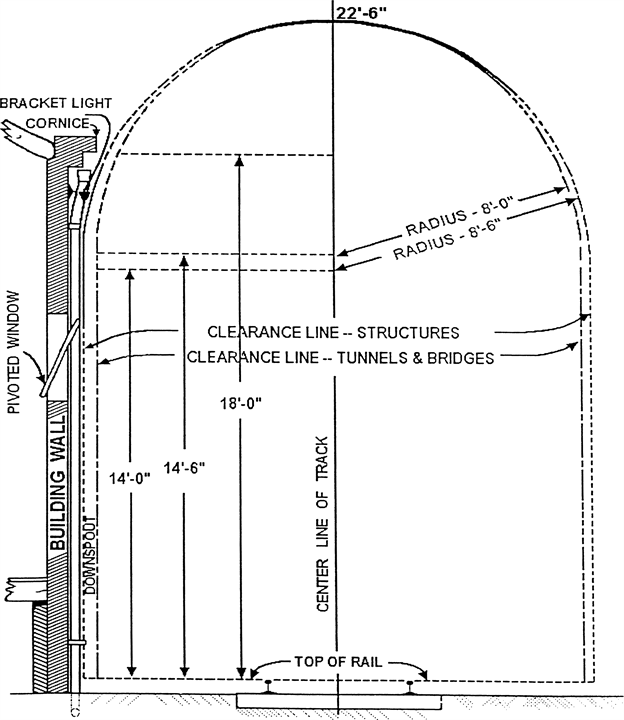 |
[Statutory Authority: RCW 49.17.010, 49.17.040, 49.17.050, 49.17.060. WSR 15-24-102, § 296-860-20040, filed 12/1/15, effective 1/5/16; WSR 07-03-163, § 296-860-20040, filed 1/24/07, effective 4/1/07. Statutory Authority: RCW 49.17.010, [49.17].040, and [49.17].050. WSR 02-17-106, § 296-860-20040, filed 8/21/02, effective 10/1/02.]
PDF296-860-20050
Maintain side clearances.
You must make sure side clearances are at least eight feet six inches from the track centerline unless clearance requirements found in Tables 2, 3, or 4 apply.
Note: | All side clearances in Tables 2, 3, and 4 that reference "the track centerline" are based on the assumption that private rail operations generally use track that is standard gauge width (4 feet 8 1/2 inches). |
Table 2 - Minimum Side Clearance for Platforms
If Your Platform Type is: | Then the Minimum Clearance Requirements Between the Track Centerline and a Platform Edge are: |
Type 1 | 4 feet 8 inches |
Platforms with heights of 8 inches or less above the top of the rail. | See Illustration 2. |
Type 2 | 7 feet 3 inches |
Platforms with heights of 4 feet or less above the top of the rail. | See Illustration 2. |
Type 3 | 8 feet |
Platforms with heights of 4 feet 6 inches or less above the top of the rail and the platforms are used primarily for loading and/or unloading refrigerator cars. | See Illustration 2. |
Type 4 | 7 feet 3 inches |
Icing platforms and supports. | See Illustration 2. |
Type 5 | |
Retractable platforms attached to permanent structures. | When not in use, use the clearance requirements for a platform of its height. |
Type 6 | |
Platforms that are a combination of Types 1 through 3. (Only Types 1 through 3 platforms can be combined.) | Platforms may be combined if the Type 1 platform has a level surface no more than 4 feet 8 inches from the track centerline to the face of the platform wall with which it is combined. |
Illustration 2 - Minimum Side Clearances for Platforms
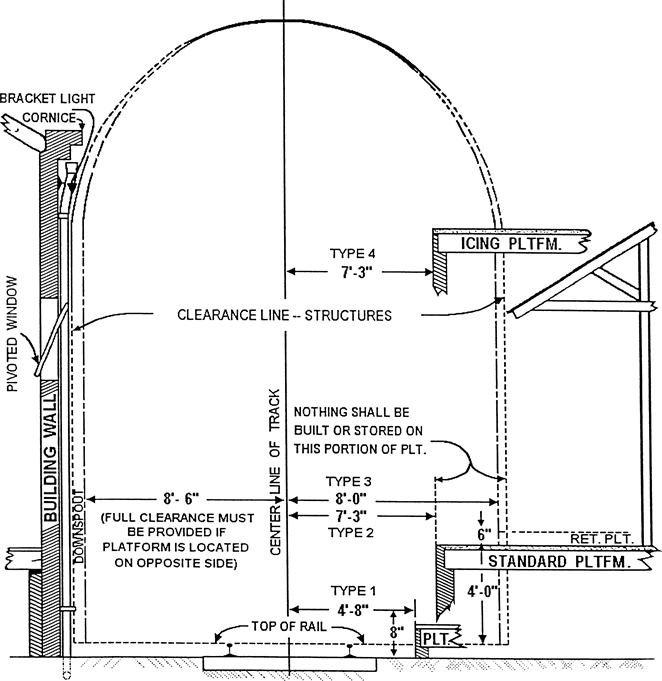 |
EXEMPTION: | Except for handrail and water barrel clearances, the clearance requirements in Table 3 do not apply to bridge decks where railroad employees couple or uncouple cars on a switching lead unless the department approves them. |
Note: | The requirements for filing a variance are located in the Safety and health core rules and chapter 296-900 WAC, Administrative rules. |
Table 3 - Minimum Side Clearances for Bridges, Tunnels and Related Structures
If your side clearance requirement involves: | Then the minimum side clearance requirements between the track centerline and the bridge, tunnel or related structure are: | ||
Bridge and tunnel sides - lower section | 8 feet | ||
Bridge and tunnel sides - upper section | Defined by the half-circumference of a circle whose: | ||
• | Radius is 8 feet; and | ||
• | Center is located on a line perpendicular to the track's centerline and 14 feet 6 inches above the top of the highest rail. | ||
• | See Illustration 3. | ||
Related structures on bridges and in tunnels - lower section structures (or portions of them) that are no more than 4 feet above the top of the rail. For example: | Defined by lines extending: | ||
• | Refuge platforms on bridges and trestles. | • | 5 feet laterally from the track centerline to a point level with the top of the rail and then diagonally upward to another point 4 feet above the top of the rail; and |
• | Water columns, oil columns, and block signals. | • | 8 feet laterally from the track centerline to a point 4 feet above the top of the rail. |
• | Cattle chutes. | • | See Illustration 3A. The shaded portion of the illustration designates the area that must be free of refuge platforms, water columns, oil columns, block signals and cattle chutes. |
Hand rails and water barrels | 7 feet 6 inches | ||
Fences of cattle guards | 6 feet 9 inches | ||
Illustration 3 - Minimum Side Clearances for Bridges, Tunnels and Related structures
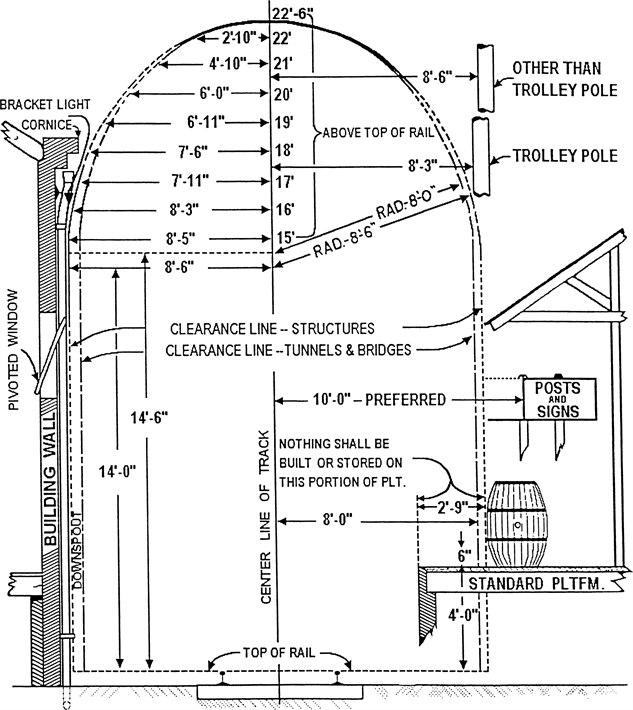 |
Illustration 3A - Minimum Side Clearance for Certain Structures in or on the Lower Sections of Bridges and Tunnels
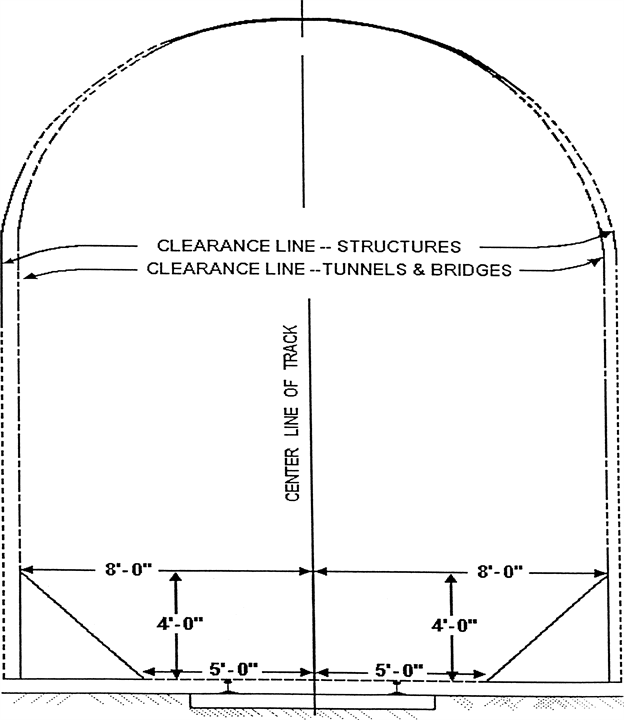 |
Note: | 1. The department must approve all minimum clearances for car pulling units and related structures. |
2. The requirements for filing a variance are located in the Safety and health core rules and chapter 296-900 WAC, Administrative rules. |
Table 4 - Other Minimum Side
Clearance Requirements*
If your side clearance requirement involves: | Then the minimum side clearance requirements from the track centerline are: | |
Type A | ||
Engine house and car repair shop doors. | 7 feet 6 inches | |
Type B | ||
Interlocking mechanism, switch boxes, and other similar devices projecting no more than 4 feet above the top of the rail. | 3 feet | |
Type C | ||
Poles supporting trolley contact. | 8 feet 3 inches | |
Type D | ||
Signals and switch stands no more than 3 feet high and located between tracks where it is not possible to allow other clearances required in this chapter. | 6 feet | |
Type E | ||
Signals and switch stands other than those described in Type B and Type D. | 8 feet | |
Type F | ||
Material, merchandise, inventory, storage bins or equipment stacked or stored on ground or platforms adjacent to tracks. | 8 feet 6 inches | |
Note: | ||
This requirement does not apply to: | ||
• | Railroad maintenance operations | |
• | Emergency situations | |
• | Local conditions that make compliance impossible. | |
Type G | ||
Space adjacent to curved track. | Increased to equal tangent track clearances. As a general rule, side clearances on curved track should be increased 1-1/2" for each degree of curvature. | |
* | Table 4 does not have an accompanying illustration. |
[Statutory Authority: RCW 49.17.010, 49.17.040, 49.17.050, 49.17.060. WSR 15-24-102, § 296-860-20050, filed 12/1/15, effective 1/5/16; WSR 07-03-163, § 296-860-20050, filed 1/24/07, effective 4/1/07. Statutory Authority: RCW 49.17.010, [49.17].040, and [49.17].050. WSR 02-17-106, § 296-860-20050, filed 8/21/02, effective 10/1/02.]
PDF296-860-20060
Maintain clearances between tracks.
You must comply with the track clearance requirements in Table 5.
Table 5 - Minimum Standard Gauge Track Clearances
If your track clearance involves: | Then the minimum clearance requirements between centerlines of standard gauge parallel tracks are: |
Main or passing tracks used for transporting cars, locomotives, motors, or like equipment | 14 feet |
Any tracks adjacent to main or passing tracks | 15 feet |
Team, house, or industry tracks | 13 feet |
Yard tracks | 14 feet |
Ladder and other tracks | 20 feet |
Note: | The following illustration will help you understand the track clearance requirements discussed in this section and WAC 296-860-20080 regulating narrow gauge rail operations. |
standard gauge track clearances
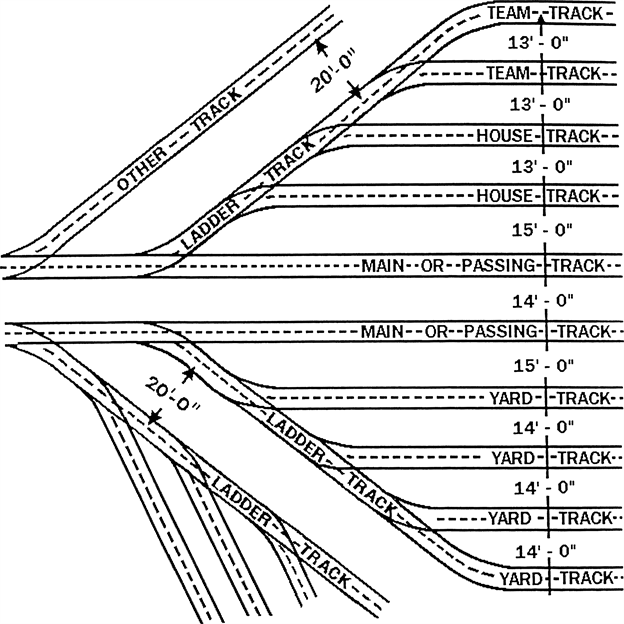 |
PDF296-860-20070
Move excessive height or width rail car loads with care.
Note: | This section regulates rail cars whose dimensions exceed ten feet ten inches wide by fifteen feet six inches high. |
(1) You must make sure your yard supervisor is given advanced notice regarding the arrival of any excess height or width cars so they can safeguard any employees working in the yard.
(2) You must make sure no one is allowed to ride on the:
(a) Roof of any excessive height car.
(b) Side of any excessive width car.
(c) Side of any car with a load extending more than five feet five inches from the car's centerline.
PDF296-860-20080
Follow these requirements to conduct narrow gauge rail operations.
(1) You must base your clearance measurements upon your widest narrow gauge cars.
(2) You must make sure the distance between the cars and objects on narrow gauge track is equal to or greater than the distance required between ten foot ten inch wide cars and other cars or objects on standard gauge track.
(3) You must comply with all other applicable requirements in this chapter.